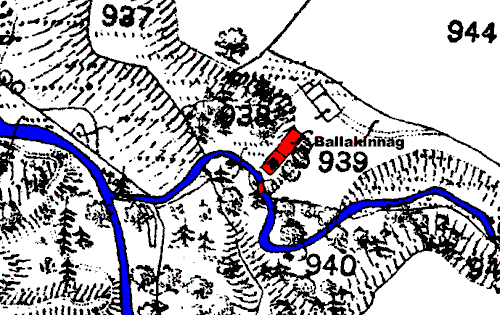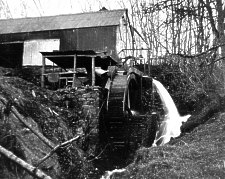
From 1868 O/S Plan VII/5 - SC 322897
Assumed location from description by Cashin - the works above the mine and water wheel post date the O/S plan

probably c. 1960 post closure of mine
|
Assumed location from description by Cashin - the works above the mine and water wheel post date the O/S plan |
|
The mine was in the Gill which is at the upper end of Glen Wyllin and the stream feeds into the main stream of Glen Wyllin running S-N to the west.
Cashin writes about the sale of both the Glen Wyllin pleasure grounds and a part of Ballakinnag to a wealthy mine owner Mr A E. Grundy who owned a coal mine in Ashton-in-Makerfield - he continues:
The main object of his interest was the deposit of fuller's earth in the upper Glen. This was probably used in connection with the tuck mill from early times, and in 1834 more discoveries had been reported. Grundy imported technicians and equipment from Brynn Hall Colliery to set up his works. This involved building a small railway powered by a waterwheel which hauled up the ex-colliery trucks by means of a rope winding round a drum attached to the axle-tree of the wheel, On reaching the works at a higher level, the wet fuller's earth was placed on a large heated plate and dried out. One man remembered that the clay was so fine and smooth that it was like cutting large pieces of butter. The earth was then sieved on screens, and the fine powder was bagged for shipment. Mr Robert Faragher was engaged for this work, and he and his family moved into the vacant Gill House (Ballakinnag) next to the works. The fuller's earth works closed down at the beginning of the first World War, and Robert Faragher, a miller purchased Glen Wyillin mill. However; the Glen Wyllin Fuller's Earth Company Limited continued in existence in name at least, until the 1920s.
Glen Wyllin, including the pleasure grounds seaward of the railway and the shore road together with the upper glen was sold to two Lancashire based businessmen in 1903, occasioned by the financial fallout from the collapse of Dumbell's Bank - part of the upper glen was sold by one partner to the other in late 1904 - Registered Deed Oct 1904 #18
dated 13 Oct 1904;Alfred Peck(Southport) sells for £1789 his share (the other held by the purchaser) to Alfred Ernest Grundy ([company] secretary, Southport) Ballacregga including the Cooil Dharry and part of Berk including those sold to Robert Cowley by Margaret R Carran and Thomas W T Carran by deed dated 13 Apr 1891 and in the sale [Reg deed Oct 1904 9] by Robt Cowley + others to sd Peck + Grundy - Grundy to excavate etc clay etc from portion of land and to lay down tramways + temporary roads;
Grundy then purchased the dwelling house(in the photo seen above the wheel, fronted by the building needed for processing the Fuller's earth) by Registered Deed Dec 1904 #14
dated 29 Nov 1904; Wm Quayle(Ballaleigh) + wife Elizabeth sell for £250 to Albert Ernest Grundy(Southport) that parcel of land in Kirk Michael known as Ballakinnag with the dwelling house + other buildings thereon erected. witt Thos S Q Cooil
Cashin also makes the suggestion that Borodaill Mill found in the 1515 Lib Assed was possibly in the same vicinity in this gill but this was very strongly argued against by Revd Rex Kissack who, along with Wm Cubbon places it in Glen Mooar where there had once been a mill. The upper end of Glen Wyllin is now known as Cooildarry (oak glen) and protected under a trust - Larch Garrad describes the private woodland and water gardens erected in mid 19th Century, probably after the initial exploitation in 1830 of the Fuller's earth. This upper glen had returned to nature by 1960 but enough restorative work had concluded by 1991 for Garrad to produce a short report on its history.
T L Cashin Two Centuries of History in Glen Wyllin: 1790-1990 Proc IoMNH&ASoc
Vol X #1 pp63/78 Douglas 1992
R Kissack The Location of a Place-Name: Where was Borodaill Proc IoMNH&ASoc
Vol X #2 pp120/122 Douglas 1994
Larch S Garrad Cooilldarry Proc IoMNH&ASoc Vol X #2 pp124/126 Douglas
1994
|
|
||
| Water powered Mills etc | ||
|
|
||
|
Any comments, errors or omissions gratefully received The
Editor |
||